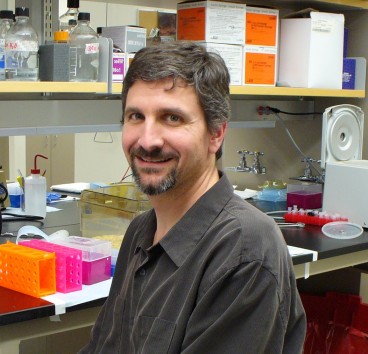Q&A with James DeGregori, Crnic Institute Challenge Grant Recipient

Dr. James DeGregori
In recognition of September as Blood Cancer Awareness Month, the Global Down Syndrome Foundation held a Q&A with Dr. James DeGregori, who has received one of the inaugural Crnic Institute Grand Challenge Grants. DeGregori received the award for his research into leukemia and Down syndrome, specifically the increase in leukemia incidence and other problems with blood cell production, including reduced immunity, in people with Down syndrome.
1. What is the co-incidence of leukemia and Down syndrome?
While individuals with Down syndrome are at a decreased risk for the development of most solid cancers (~2 fold), they are at a 10-50 fold increased risk of developing leukemia (most commonly B-cell acute lymphoblastic leukemias), with a striking ~500 fold increased risk for acute megakaryoblastic leukemia (AMKL; normally very rare).
2. Please describe the nature of your research.
Down syndrome is associated with a striking increase in leukemia incidence, as well as a variety of other problems associated with blood cell production, including reduced immunity. Using mouse models, we will determine whether deficiencies in blood cell production originate in the reduced function of blood stem cells. Furthermore, we will ask whether the increase in leukemias associated with Down syndrome is actually caused by the stem cell defects: Does the poor health of these stem cells enhance the evolution of leukemias? These studies could indicate mechanisms to improve blood cell function and prevent leukemias in people with Down syndrome.
3. How could your research end up benefiting people with Down syndrome?
If we can better understand how trisomy for chromosome 21 (individuals with Down syndrome have 3 chromosome 21s per cell instead of 2), then we can hopefully develop methods/treatments that can alleviate some of the negative consequences of this trisomy. One of our ideas is that trisomy is inducing a “stress response” in cells, resulting in their reduced function (such as in blood cell production) and also leading to selection for leukemia-causing mutations that overcome this stress response. If we could tone down this stress response, we might be able to lessen both impaired blood cell production and increased leukemia incidence.
4. How important is the Crnic Supergroup in helping your research and promoting collaboration?
Very important. We are already collaborating with Dr. Katheleen Gardiner’s group for the mouse model, and we will share critical gene expression data with other Supergroup members who are also looking at how trisomy impacts cellular programs. Most importantly, when you get a bunch of smart people together with varied expertise, new ideas and new approaches will be generated.
5. How important is the Crnic Institute funding for advancing research on the CU campus?
Absolutely critical. My lab had no involvement in Down syndrome research before last year, so the funding allowed us to enter into this field. And as I mentioned above, the Crnic Institute’s role is more than in just providing necessary funds: They have attracted a lot of bright and innovative scientists in Colorado to better understand and treat a common problem: the negative consequences of trisomy 21.
6. Please tell us a little about yourself?
I have been doing cancer research for almost 30 years. I started doing research at the University of Texas at Austin as an undergraduate (with Dr. Hank Bose), did my thesis research with Dr. Earl Ruley at MIT, and then did postdoctoral training at Duke University with Dr. Joseph Nevins. I have been a faculty member in the CU School of Medicine since 1997. My lab seeks to understand both the evolutionary origins and the vulnerabilities of cancer cells, and most of our studies have focused on leukemias. Our research has been heavily funded by the National Cancer Institute and by the Leukemia and Lymphoma Society.
7. Is there anything else you’d like to add?
My cousin had Down syndrome and succumbed to leukemia when she was about 20. She has always served as an inspiration for our leukemia research, and I have wanted to pursue the connection between Down syndrome and leukemias for many years. The Crnic Institute has provided my lab with this opportunity.
Recent Posts
- GLOBAL LEADERS – An Exclusive Interview with Erin Suelmann, Executive Director of the Down Syndrome Association of Greater St. Louis
- Sleep Apnea Across the Lifespan in People with Down Syndrome
- Government Profiles: Robert Aderholt (R-AL) & Tammy Baldwin (D-WI)
- Connor Long & Josh Peck: A GLOBAL Bromance
- GLOBAL Launches Pilot Fitness Program using Mann Method PT

 Experience our inspirational and groundbreaking videos and photos. Our children and self-advocates are beautiful AND brilliant!
Experience our inspirational and groundbreaking videos and photos. Our children and self-advocates are beautiful AND brilliant! Make sure your local Representatives are on the Congressional Down Syndrome Task Force.
Make sure your local Representatives are on the Congressional Down Syndrome Task Force.